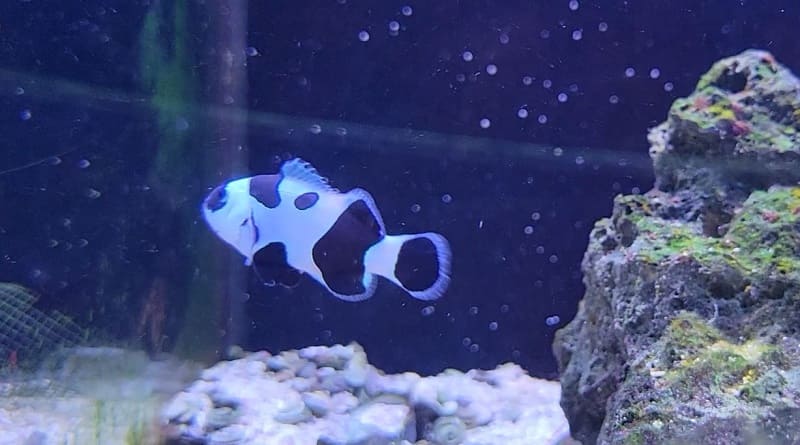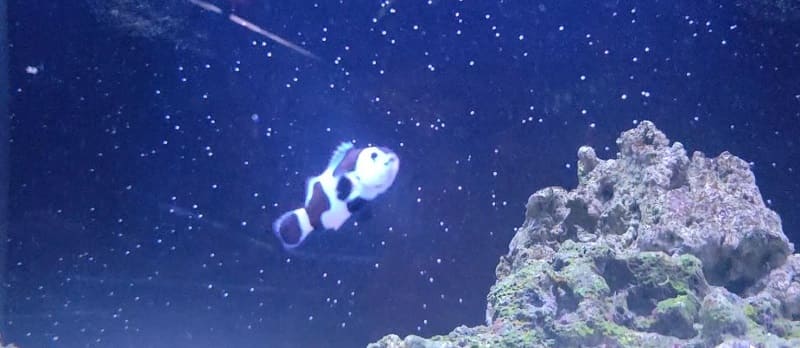Few creatures in the mesmerizing world of marine life capture the attention and wonder of both seasoned aquarists and newcomers quite like the Black Stormtrooper Clownfish. This extraordinary species captivates the attention of marine enthusiasts with its impressive appearance and captivating behavior, sparking a newfound interest in the marvelous world hidden beneath the ocean’s depths.
While traditional Clownfish have long been admired for their vibrant orange hues, the Black Stormtrooper Clownfish breaks away from convention with its stunning black and white pattern resembling Star Wars’ iconic Stormtroopers. The extraordinary aquatic creatures bear a striking resemblance to majestic suits of armor, arousing wonder and astonishment as they beckon onlookers into their enchanting realm.
Delving into the mysterious world of Black Stormtrooper Clownfish uncovers mysteries surrounding their native environment and exposes the fragile balance that nurtures these captivating beings. Emerged from tropical waters in Indo-Pacific areas like Southeast Asia, Australia’s Great Barrier Reef, and even stretching to the Red Sea, they possess a crucial function within complex marine systems.
Within their natural habitat, these captivating fish establish crucial symbiotic connections with sea anemones by taking refuge in their elegant tentacles. This exceptional alliance not only ensures the safety of clownfish but also grants anemones a consistent supply of nourishment—an exemplification of the harmonious interdependence present in marine ecosystems. The allure of Black Stormtrooper Clownfish extends beyond their eye-catching appearance; it is additionally enhanced by captivating behavior that captivates observers.
Through playful interactions amongst themselves or comically “clowning” around aquariums—a privilege afforded only to those responsible for caring for them—these fish effortlessly bring joy and amusement.
However undeniable their enchanting presence is within marine fishkeeping circles may be crucially reminding ourselves that ensuring their well-being necessitates unwavering dedication, knowledge, and an authentic passion intertwined with marine life itself. Mimicking an appropriate environment mirroring natural habitats remains paramount; directly affecting health alongside overall happiness.
In this blog, our objective is to explore the depths of knowledge surrounding Black Stormtrooper Clownfish and provide valuable insights on how to create an optimal aquarium setting. By covering topics such as choosing suitable tank companions, maintaining a well-balanced diet, and even uncovering breeding possibilities for these fascinating creatures, we aim to empower you as a conscientious and caring keeper of these marvelous marine beings.
So let us plunge into the realm of Black Stormtrooper Clownfish – where shimmering waters brim with fascination and nature’s artistic beauty comes alive in an awe-inspiring underwater spectacle. Get ready to be captivated as we delve into the mysteries surrounding these extraordinary aquatic creatures and uncover the hidden marvels beneath shimmering ocean depths.
Meet the Black Stormtrooper Clownfish
The mesmerizing variant of the well-known Clownfish species is scientifically labeled as Amphiprion ocellaris, commonly referred to as the Black Stormtrooper Clownfish. This captivating aquatic creature gets its name from its distinctive coloration, reminiscent of the iconic and widely recognized Stormtroopers found in the Star Wars franchise. In contrast to the vibrant orange tones typically associated with traditional Clownfish, the Black Stormtrooper Clownfish’s enigmatic black-and-white pattern adds an element of fascination that makes it a highly desirable addition for any aquarium enthusiast.
Origins and Natural Habitat
The natural habitat of the Black Stormtrooper Clownfish spans across the warm waters of the Indo-Pacific region, including the Red Sea, the Great Barrier Reef of Australia, and parts of Southeast Asia. These enchanting fish are commonly found sheltering in the tentacles of sea anemones, a symbiotic relationship that provides protection for the clownfish and food for the anemone.
Setting Up the Perfect Aquarium
To ensure the health and well-being of your Black Stormtrooper Clownfish, setting up the right environment is crucial. Here are some key factors to consider:
1. Tank Size: Black Stormtrooper Clownfish can thrive in a variety of tank sizes, but it is generally recommended to have at least a 20-gallon tank for a single pair. Larger tanks can accommodate more individuals or other compatible fish species.
2. Water Parameters: Maintaining proper water quality is essential. Keep the temperature between 75°F to 82°F (24°C to 28°C) and maintain a stable pH level between 8.1 to 8.4. Regularly test water parameters and perform water changes to prevent harmful fluctuations.
3. Filtration and Circulation: Invest in a quality filtration system and ensure adequate water circulation to maintain clean and oxygen-rich water.
4. Substrate and Decorations: Use fine-grain sand as the substrate to mimic the natural environment and provide hiding spots using live rocks or artificial decorations. Remember to choose items that won’t harm the fish or damage their delicate fins.
5. Lighting: Provide moderate lighting, as excessive brightness can stress the fish and promote algae growth.
Companions for the Black Stormtrooper Clownfish
When selecting tankmates for your Black Stormtrooper Clownfish, choose species that are known to be compatible and peaceful. Avoid aggressive or territorial fish that might bully the clownfish. Some suitable tankmates include:
1. Other Clownfish: While it’s generally best to keep only one clownfish species in a tank to avoid aggression between different types, multiple Black Stormtrooper Clownfish can often coexist peacefully.
2. Small Community Fish: Consider species like Gobies, Damsels, and certain Wrasse, but always research each species’ compatibility and care requirements before introducing them.
3. Avoid Large Predators: Keep in mind that larger predatory fish may see the small clownfish as potential prey, so it’s best to avoid mixing them.
Feeding and Nutrition
In the wild, Black Stormtrooper Clownfish are omnivorous and feed on algae, plankton, small crustaceans, and even tiny fish. In captivity, replicating their natural diet is essential for their health. A well-balanced diet includes:
1. High-Quality Commercial Foods: Choose high-quality flake or pellet foods specifically formulated for marine fish.
2. Frozen Foods: Offer occasional treats of frozen foods like brine shrimp, mysis shrimp, and chopped seafood.
3. Algae and Plant Matter: Supplement their diet with algae-based foods or seaweed sheets to mimic their natural feeding habits.
4. Avoid Overfeeding: Overfeeding can lead to water quality issues, so offer only what the fish can consume in a few minutes, two to three times a day.
Breeding the Black Stormtrooper Clownfish
For those who wish to delve deeper into the world of marine breeding, the Black Stormtrooper Clownfish can be an exciting species to work with. These fish are known to be relatively easy to breed in a well-maintained aquarium with stable conditions. However, breeding requires careful consideration and commitment, as it involves providing the right environment, food, and protection for the eggs and young fry.
Conclusion
The Black Stormtrooper Clownfish is a captivating and alluring species that can add a touch of wonder to any marine aquarium. With their unique appearance and charming behavior, they have become a favorite among hobbyists. By providing them with the right environment, companions, and nutrition, you can ensure the well-being and longevity of these enchanting fish in your care. Remember, the world of marine fishkeeping is both rewarding and challenging, and continuous learning and attention to detail are key to success. Happy fish keeping!


